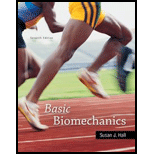
Basic Biomechanics
7th Edition
ISBN: 9780073522760
Author: Susan J Hall
Publisher: McGraw-Hill Education
expand_more
expand_more
format_list_bulleted
Concept explainers
Textbook Question
Chapter 10, Problem 6AP
A Dallas Cowboy carrying the ball straight down the near sideline with a velocity of 8 m/s crosses the 50-yard line at the same time that the last Buffalo Bill who can possibly hope to catch him starts running from the 50-yard line at a point that is 13.7 m from the near sideline. What must the Bill’s velocity be if he is to catch the Cowboy just short of the goal line? (Answer: 8.35 m/s)
Expert Solution & Answer
Want to see the full answer?
Check out a sample textbook solution
Chapter 10 Solutions
Basic Biomechanics
Ch. 10 - A runner completes 6 laps around a 400 m track...Ch. 10 - A ball rolls with an acceleration of 0.5 m/s2. If...Ch. 10 - A wheelchair marathoner has a speed of 5 m/s after...Ch. 10 - An orienteer runs 400 m directly east and then 500...Ch. 10 - An orienteer runs north at 5 m/s for 120 s and...Ch. 10 - Why are the horizontal and vertical components of...Ch. 10 - A soccer ball is kicked with an initial horizontal...Ch. 10 - If a baseball, a basketball, and a 71.2-N shot...Ch. 10 - A tennis ball leaves a racket during the execution...Ch. 10 - Prob. 10IP
Ch. 10 - Answer the following questions pertaining to the...Ch. 10 - Provide a trigonometric solution for Introductory...Ch. 10 - Provide a trigonometric solution for Introductory...Ch. 10 - A buoy marking the turn in the ocean swim leg of a...Ch. 10 - A sailboat is being propelled westerly by the wind...Ch. 10 - A Dallas Cowboy carrying the ball straight down...Ch. 10 - A soccer ball is kicked from the playing field at...Ch. 10 - A ball is kicked a horizontal distance of 45.8 m....Ch. 10 - A badminton shuttlecock is struck by a racket at a...Ch. 10 - An archery arrow is shot with a speed of 45 m/s at...
Knowledge Booster
Learn more about
Need a deep-dive on the concept behind this application? Look no further. Learn more about this topic, bioengineering and related others by exploring similar questions and additional content below.Recommended textbooks for you
 Principles Of Radiographic Imaging: An Art And A ...Health & NutritionISBN:9781337711067Author:Richard R. Carlton, Arlene M. Adler, Vesna BalacPublisher:Cengage Learning
Principles Of Radiographic Imaging: An Art And A ...Health & NutritionISBN:9781337711067Author:Richard R. Carlton, Arlene M. Adler, Vesna BalacPublisher:Cengage Learning



Principles Of Radiographic Imaging: An Art And A ...
Health & Nutrition
ISBN:9781337711067
Author:Richard R. Carlton, Arlene M. Adler, Vesna Balac
Publisher:Cengage Learning



GCSE PE - ANTAGONISTIC MUSCLE ACTION - Anatomy and Physiology (Skeletal and Muscular System - 1.5); Author: igpe_complete;https://www.youtube.com/watch?v=6hm_9jQRoO4;License: Standard Youtube License